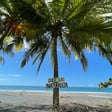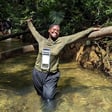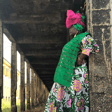Become a Creator today!Start creating today - Share your story with the world!
Start for free
00:00:00
00:00:01

Audio Postcard: Cap-Haitien, Haiti and the Citadelle
This audio postcard shares audio -- music and interviews -- from my visit to Cap-Haitien, Haiti in December 2019. We were there for a dance retreat and visited the Citadelle Laferrière to learn some Haitian Revolution history. At this time in history, we need some liberatory and ancestral inspiration.
Transcript
00:00:06
Speaker
and
Introduction to Jazz's Audio Postcard Series
00:00:35
Speaker
Greetings, fam. Welcome to Spirit in the Material World. I'm your host, Jana Zinsi, also known as Jazz. This is not a full podcast episode. but something I like to call an audio postcard. I'll be sharing some short snippets from my travels to give you a sense and feel of a place through sound.
Dance Retreat in Haiti
00:00:55
Speaker
The drums you heard are from Haiti, specifically when I went there in 2019 on a dance retreat. I traveled with singer Riva Nairi and seven other amazing women to study dance with her and this incredible Haitian dance group called Tu Se Pa.
00:01:12
Speaker
They are like Haitian Alvin Ailey, in my humble opinion. We toured the Citadel La Ferriere near Cap Haitian. Please forgive my French. I do not have a very good French accent, but bear with me. And that is the mountaintop fortress that was built to keep French colonizers out after the revolution. The massive fortress has 360 degree views.
00:01:37
Speaker
of the surrounding mountains, the valleys, and most people ride mules to the entrance, like we did. The cannons and cannonballs are still intact, so it feels like a walk back in time, touching the earth where revolutionaries walked. Down below the citadel, there was a complex of ruins and fields where we got to take dance classes.
Spiritual Dances and Ancestral Connections
00:01:58
Speaker
We danced for Gede.
00:01:59
Speaker
Haitian voodoo spirits that are associated with death and also fertility. They are rowdy, sexual, and mischievous, and their movements embody that energy. It's hard to put into words what it felt like to do ancestral spiritual dances with a view of the citadel, a symbol of Haitian freedom and revolution towering over us and watching us.
00:02:21
Speaker
I felt just so touched by ancestral love and really honored to be there. And it's an experience that my mind, body, and spirit will never forget.
Delays and Current Events
00:02:33
Speaker
I planned to record and post this on January 1st, Haitian Independence Day, but life had other plans. I got really sick and then on the first, New Orleans, where I live, experienced a terror attack. So I've been a bit thrown off from the schedule I wanted to keep this year. But this the story is important today and for the days to come. I'm taping this on inauguration day in the United States.
00:03:02
Speaker
and with the incoming administration, I believe we will need some inspirational stories about resistance and revolution. Our ancestors have given us keys, and it is my hope that we won't need to use them, but also that we are prepared to receive their wisdom, in case we do.
Citadel La Ferriere's History and Importance
00:03:22
Speaker
and so see My, yes, everyone come to see them. Today is very poorly. And here he got a pick martin and the big a big castle, like a citadel. hey Yes, a citadel, the man was built that is Roland Henry Christophe. Okay. Yes, a citadel never used, never finished. It was past 14 years to building this tree. And Saint-Souci Palace, the residence we've had the cane, and Gramey, it's a property. And Gramey, it's behind the citadel. And the citadel is a big castle, big fortress.
00:04:00
Speaker
and but he's there for protect Haiti right yeah and the time right now when he was built the cancer would out no cement no foundation yeah he was using marriage about blood of the cow gelatin and limestone oh he make a marriage to be the citadel yeah you San Susie Palace was finished completely and it was destroyed by earthquake, 7 May 1842. Yes, it's citadel never used, never finished. Do you know why citadel never finished? Why? Ennui Christophe was a sweet sign. He was killed himself. Oh, right. Yes, 8 October 1820. Do you know why? And a 15 August.
00:04:43
Speaker
It's a celebration to Capa Isha. And with Christophe living in the town to Milo, you want to go in the celebration at Capa Isha, you got a little town, they call it Limonade. It was passed first to Limonade and the church. When you're almost in the church,
00:05:01
Speaker
He took a couple of hours, and after they stand up, he was said the priest, hey sir, it's your time to finish the mess. I gotta go. The priest said, no, King, you are King, and your parents, and the priest, and the church. And we can stop every for that. once to make a fire do You want to make a with the priest. Sometime he was through the stroke. He was further.
00:05:28
Speaker
and after he was par-a-lazy, wife came in with fallen married, Lise, and she's born in the Italy. and She took one of weaver, daughter, American, to give Ennio Christophe medicine. Ennio Christophe was passed a couple months to take a medicine. When he says the proclamation, anyone got accepted.
00:05:51
Speaker
The workers, governor, general, soldiers, don't hear any request of anything. Any request of Siddharth the faith, Napoleon Bullock who has come back to Haiti, he don't want anybody killing. yeah He was killing himself. That was uncertain and never used, never finished. Yes.
00:06:13
Speaker
about I'm so tired right now. Yeah, no, you're doing amazing. You just told me all this history and you're running up the hill. That was beautiful, thank you.
Haiti's Path to Independence
00:06:25
Speaker
Yeah. We got an independent 1804. 1805 or 06. will start to build it. oh It was past 14 years to build this tree.
00:06:38
Speaker
I'm so tired. Yeah, no, you're amazing. Thank you. So it was built after the revolution. Yes. Okay. Okay. One day, they don't get slave. Everyone working together. No slave. Yeah. That's what it should be, you know? Yes. They got a collective workers. Right. Exactly. Patu number one. Patu. Yeah. The leader. Andela, Patu. Andela. Yeah. Good job, Patu. Pat, you do it! Yeah! Like Obama! Obama, do it! That's right! I'm glad you enjoyed my service! Yes! Yes, absolutely! Slow down, Pat, you slow down! Stop there! Welcome to the biggest part of the hamburgers!
00:07:41
Speaker
and welcome to the most famous canon museum in the world according to the experts of the UNESCO but before going any further let me tell you that according to the historians this island knows four great periods before Christopher Columbus set foot here on December the 5th 1492 there were 250 000 people who live on all the island They were formed specifically to the south coast of Venezuela to establish themselves here. And imagine that three years only after ah Christopher Columbus came in here, only half of that population survived because they were enslaved by the Spanish to fetch gold for them. After 23 years only, only 15,000 of them survived.
00:08:30
Speaker
Basically there were 250,000 and after 23 years only 15,000 of them survived. That's why in 1503 they sent for black people from Africa ah to take over who because they were stronger than those Indians. It is to say that the first black people live here from Senegal.
00:08:54
Speaker
and 1503 and it was after 207 years of Spanish slavery in 1697 the island was divided into two parts to give birth to two different countries thanks to a treaty between the French and the Spanish and the east of the island was led by the Spanish while the west the west part oh was um led by the French. It was also after 107 years of French slavery, that on January the first 1804, Haiti became the first black people in the world. And also it was the only one successful slave's revolt, because the Martinique tried, the Guadelpen tried and they failed.
00:09:42
Speaker
And it is us who gave the first step to the human right to say that no to slavery, and everyone is equal. And we were free from our French on January 1, 1804.
00:10:01
Speaker
It was a gift from the French, because at any time they would not want to free us. Because in 1789, sugar, which values what petroleum is for this moment, three quarters of sugar from all the French colonies together were from here. In comparison, all the British colonies together provided six million pounds to the British, while only from here the French got 11 million pounds.
00:10:28
Speaker
And, yeah, that's why they would want to come back from time to time.
Architectural Significance of the Citadel
00:10:34
Speaker
Intelligently, Jean-Jacques Dessalines, who was the first president of this country, took adequate, unhappily, the knife of the same year and asking to the generals to build forts on the top of the mountains in order to protect the country against an eventual attempt of the French.
00:10:49
Speaker
that in nikasov was already a general's year started building the saddle by the sides of other nine forts and 14 castles only in the north and part of haiti and him the builder of the saddle in nikasov he wasn't born in haiti He was born in Granada Island from a slave's owner and a black lady who worked for that slave's owner. ah Because of his color and his origin, his father wasn't really proud of him. He just gave him to a British captain who entered Carpacean. At that time, in Microsoft, the build of this saddle, Austin Sesipalis, he was only eight years old. He started working in Carpacean as a baker and a bakery which was called Boulangerie d'Lacouen at only
00:11:33
Speaker
eleven years old At 17 years old, he took part among the 500 black volunteers who went from here to go to Southern Georgia to help that part of the United States got its independence. He was 17 years old, and they found this dossier over there in a hospital which testified that he was 17 years old because he took a bullet in his left leg, and they took care of him in a hospital over there.
00:11:57
Speaker
yeah doing the independence war he was already a general but her unfortunately two years after the independence oh on ah October 17 Jean-Jacques Dessalines was the first president of the country was murdered by the Asian leaders by the Asian generals because ah they are wanted to take all the lands left by the Europeans for themselves and placing the former slaves on those lands to work for them as if they wanted to take over. Jean-Jacques Dessalines said no to that kind of injustice. He asked for the verification of the titles of those lands. That's why he was murdered by the Asian leaders.
00:12:37
Speaker
And in the case of was the most ancient officials supposed to take over, supposed to guard the power after the silent death. And because once more of his origin and his color, the military and power points give birth to a new constitution. That constitution would accept any case of as a president, but him in the case of he would only have the power of a soldier, just the power to verify the decision taken by the great concealer of the state at that time led by the military and power points.
00:13:06
Speaker
And Christophe said no to that kind of presidency. He went back in the northern part of Haiti where he was already a generalist and he proclaimed himself president on the northern part of Haiti. It is to say now not only the island ah was divided into two parts but it itself just two years after the independence was divided into two parts.
00:13:27
Speaker
ah to give birth to the Republic of the South led by Alex and Petion and the NAF led by Ennui Christophe. After four years of residency Ennui Christophe proclaimed himself king.
00:13:40
Speaker
ah oh in November 1811 until his death at San Jose Palace from his legacy we have this that we are very proud of him of it which is the biggest photo of the hammer cars and also the most famous cannon museum in the world because it was conceived for 365 cannons mothers and murders and ah because after the king's death it was looted and abandoned now we can count 163 cannons mothers which are from Spain, Portugal, France, Haiti, Italy too and
00:14:26
Speaker
oh Now, all the bullets were 500,000 with all types. And also, this is only the only photo of the Hamakas where they combined the style of the two main European school of fortification. The first one was called the Vuban.
00:14:47
Speaker
Wobban was the commissary of war of least the 14. According to the thoughts that Wobban built, the walls would be shot like this and thick enough in order to be able to place the maras behind them to shoot them like this to which four kilometers. And what ah they did, they filled the biggest cannonball with small cannonballs and powder to have them explode.
00:15:09
Speaker
and ah has like a boom and the smallest one were used in the cannon to shoot them switch to which are two kilometers yeah And de ah the other school was Montalans-Bares I, which wanted that there was the walls be high like this so that they can build the saddle and bastions for each wall protection. If this part is attacked, that one ah can defend it. And inside of each bastion, we're gonna see a kind of um a shaft or tower to attract light, to avoid darkness. and And so in case of fire, so that they can extinguish it easily. Yeah, when you're ready, we're gonna go inside.
00:15:49
Speaker
Yeah, feel free to ask question. Okay, yeah.















